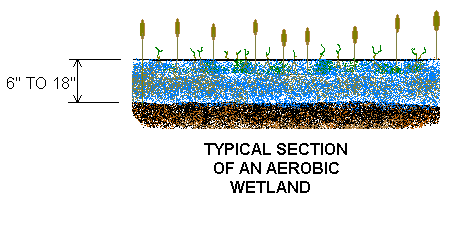An aerobic wetland consists
of a large surface area pond with horizontal surface flow. The pond
may be planted with cattails and other wetland species. Aerobic wetlands
can only effectively treat water that is entirely alkaline.
In aerobic wetland systems, metals are precipitated through oxidation
reactions to form oxides and hydroxides. This process is more efficient
when the influent pH is greater than 5.5. Aeration prior to the wetland,
via riffles and falls, increases the efficiency of the oxidation process
and therefore the precipitation process. Iron concentrations are efficiently
reduced in this system but the pH is further lowered by the oxidation
reactions.

A typical aerobic wetland will have a water depth of 6 to 18 inches.
Variations in water depth within the wetland cell may be beneficial
for performance and
longevity. Although shallow water zones freeze more quickly in winter,
they enhance oxygenation and oxidizing reactions and precipitation.
Deeper water
zones provide storage areas for precipitates but decrease vegetative
diversity.

Return
to AMD Stakeholders' page
